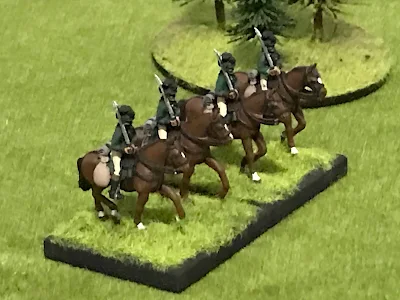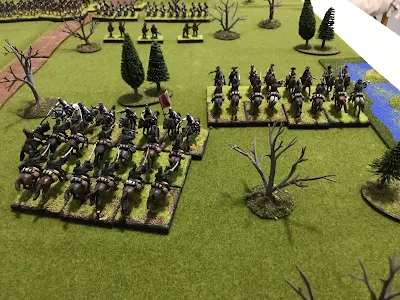Thursday, November 26, 2020
Tuesday, November 17, 2020
Edward Suren "Willie" miniatures
In cleaning out The drawers and storage boxes on my painting table I found a small group of 30mm Suren figures. I had started working on them back in the late 1980's and like too many projects they fell to the way side. Curse that butterfly effect!
I have always found the Edward Suren miniatures to be outstanding, and after all these years they have not lost their charm. I really like them and hope to fund the money to add some regiments to my collections. I do wonder after all these years how the molds have held up and what the castings look like today.
As an aside during a trip to Great British in the early 1980's I visited the Black Watch Museum. I was most excited to see the Suren diorama about the attack on Fort Ticonderoga. It was amazingly detailed and the staff was most amused after an hour there I was still looking at it. Unfortunately none of the pictures I took came out so I have no visual memory if it. I do wonder if it is still there and what condition it is in. Also, if any readers of this blog know if the location of any other Edward Suren dioramas please let me know as we are planning a visit to Great British
Thursday, November 12, 2020
New Rivers, a wonderful gift
I received an incredible surprise the other day. In response to a post I made here and on the Fife and Drum Miniature forum I received a new set of rivers for my table set up. These were made by Bill Nevins who runs Kings Mountain miniatures. Bill makes incredible terrain and the terrain of his bases for figures. Tgey are diorama like in quality. Turns out Bill was working in making roads for one of his displays and took up this as a challenge. Can I make something like this?
There are two sets of rivers. The largest is 6" wide and about 12' long. It includes a number of pie shaped pieces to add twists and turns. There us also a section with a ford and another section with a smaller stream branching off from it. Then there are. A number of smaller streams about 2" wide. More then enough for any game.
 |
| Basic canvas with chalk applied. |
 |
| Then painted blue and gloss added. |
The rivers were made from stretched canvas that artists use for painting on. Acrylic caulk is then spread over the canvas and painted with acrylic gloss paint. I asked for a very deep dark blue but you can use any color really. Lastly it us given A couple of coats of gloss medium. Smaller details like highlighting and a few dashes of white to represent waves add to the effect. The fords have small islands on them. They are covered in a static grass.
 |
| Most of the pieces layer out. |
 |
| A big piece with a narrow stream branching off of it. |
 |
| A wide and a narrow river ford. |
I like these very much and in the future will be seeing much use on my table. they are a very flexible system which is just what I was looking for. Bill mentioned that this system can also be used for making roads.
Thank you Bill!
 |
| Crossing the River. |
 |
| Get off my lawn |
Wednesday, November 11, 2020
Armistice Day
My grandfather, Edward McNamara from Lexington Massachusetts served with the 101st Regiment (Medical company), 26th Yankee Division in the first world war. He seldom talked about it, and when he did it was a terrible memory which haunted him. It was only later that I found out he was mentioned in the division's orders and was decorated for heroism. He never mentioned this to me. I found out later through my own research. But I will always remember his smile when he told me how at 11:00 A.M. on 11th November the guns stopped and he and his friends knew they would live, knew they had survived. He went on to raise a family and contribute to society. During the next war he built ships for the Navy at the Charlestown Navy yard.
And as this date is now called Veterans Day I say thank you to my father in law, Aldrich Stevens who served in the 3rd Ranger Battalion (Darby's Rangers) in the Second World War. He saw service with them at North Africa, Sicily and Italy. Seriously wounded he did not make the Anzio landing and thus missed the action at Cisterna (although he may have listened to the last radio calls while at headquarters). Like my grandfather he too was haunted by the memories of what he saw, experienced and especialy those he lost. But again he went on with life. Due to the GI bill he got a education, raised a family and contributed to society.
I remember their sacrifices and hope both men have found peace.
Sunday, November 8, 2020
The Battle of Cowpens 1781
 |
| General Morgan gets ready for some down right fighting! |
 |
| The battlefield from the American point of view. Cavalry in reserve and main line of Continental infantry. Ahead are militia regiments and ahead of them rifle armed skirmishers. |
Turn #1
British line advances onto board. They advance steadily against the American line. They will have to close with the enemy quickly due to limited number of turns.
 |
| 7th Regiment of Foot |
The British Cavalry fan out on both flanks and approached American skirmish line. The American skirmishes stay ahead of them peppering them with accurate rifle fire. The light infantry split move lets skirmishes fall back after firing.
The American fire causes both cavalry troops to check morale, which they fail and fall back. They are later rallied and return to the fight.
Turn #2 - 4
British line continue their advance. The Royal Artillery takes aim at enemy and starts a slow but steady fire against the American Militia regiments.
Turn #4 and 5
Reinforcements arrive edge of board. Tarleton brings the remainder of the British Legion Cavalry and the 1/71st Highlanders onto the field.
Artillery hits militia line and causes a morale check, but the Militia holds. They are helped by the presence of the two American commanders, Morgan and Pickens.
 |
| Legion cavalry. |
Turn # 6 and 7
The American combined cavalry under It. Col. William Washington charge the British left flank. In the melee both the Light and Legion infantry fall back to rally after their defeat.
Turn #8 and 9
The American militia and rifles fall back to join the Continental line. The rifles, using the rules split move are able to move into range, fire and then fall back out of danger.
Morgan readies his main line for the advancing British. The Continentals firm the center with Militia and Rifle units to both sides.
Turn #10
The British line all move into musket range. The 71st and 7th exchange fire with the Americans militia. Pickens and Morgan steadied them and the line holds. The return fire causes the 7th to rout. The poor 7th had been steadily losing men advancing against first the rifles then the militia. They have been slowly whittled down.
On the other flank the Legion Infantry and British Lights destroy the rifles, but take serious hits from the Militia and Continental line. In the exchange of musketry that follows both units take hits against their commanders and have to test morale. Both fail and rout back. In these rules light troops can aim at enemy commanders in a battalion. It's hard to hit them but when they do it causes morale problems.
The 71st now alone! They have the Continental Light battalion and the Militia to its front and is heavily outnumbered. The officers look about for support, where us Tarleton?
Turn #11
Tarleton, must test morale of his horse after the infantry routes past them. They fail and turn about and race from the field. Morgan, waves his hat and the entire American line moves forward to clear the field. The poor 71st is an island surrounded by American troops.
The commander of the Highlanders is heard to mutter, " This is what comes of being led by a beard less boy."
 |
| It was not my day! |
Epilogue:
A decisive battle much as the historical one was. The rules used worked very well and provided a fun and enjoyable game. The split move of the light troops works very well in giving skirmishes the ability to shoot and run away.
I think the results of the fight are pretty much pre ordained. The British have but one commander who cannot be everywhere at once. The Americans have multiple commanders who can steady troops. Also, putting a time limit on the game forces the British to just move forward quickly and no fancy tactics. But in the end Morgan had an excellent battle plan designed to defeat his enemy.
























